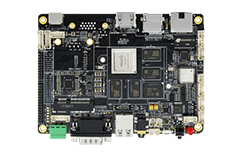4. Customized Android firmware¶
4.1. preface¶
There are two ways to customize Android firmware:
Change the source code and compile the firmware.
Tailoring the existing firmware.
In the former method, Android can be customized from all levels, with great freedom, but high requirements for the compilation environment and technology, which can be referred to Compile Android firmware. Now introduce the latter method, which is divided into three phases: unpacking, customization and packaging. The host operating system is Linux, and the tools used are open source software.
4.2. Firmware format¶
Unified firmware release_update.img contains the boot loader loader.img and the actual firmware data - update.img.
release_update.img
|- loader.img
`- update.img
update.img is a composite file containing multiple files described by package-file. A typical package-file is:
# NAME Relative path
#
#HWDEF HWDEF
package-file package-file
bootloader RK3288Loader_uboot_Apr212014_134842.bin
parameter rk3288-3.10-uboot-data1G.parameter.txt
uboot Image/uboot.img
misc Image/misc.img
resource Image/resource.img
kernel Image/kernel.img
boot Image/boot.img
recovery Image/recovery.img
system Image/system.img
backup RESERVED
update-script update-script
recover-script recover-script
package-file
Packing instruction file for the update.img, a package-file is also contained in the update.img.
RK3288Loader_uboot_Apr212014_134842.bin
Boot loader(i.e. bootloader).
rk3288-3.10-uboot-data1G.parameter.txt
Parameter file, which can be used to set the kernel startup parameters, and there are important partition information in it.
Image/misc.img
Image of the partition, which is used to control whether the Android starts normally or enters the emergency mode(Recovery Mode).
Image/kernel.img
Android kernel.
Image/resource.img
Resource image, which contains the boot image and the device tree blob information of the kernel.
Image/boot.img
The memory boot disk (initrd) of the Android kernel, which is the root file system that is loaded first after the kernel startup and contains important initialization actions, in general, the change is not required.
Image/recovery.img
Image in the emergency mode for Android, which contains the root file system of the kernel and emergency modes.
Image/system.img
Corresponding to the /system partition of Android, and it is the following custom object.
Unpacking, is to extract the update.img from release_update.img, then the extracted with package-file statement by multiple files.
Packaging is an inverse process to synthesize the multiple files listed in the package-file to update.img, add to the loader.img, and finally generate the release_update.img.
4.3. Tools preparation¶
git clone https://github.com/TeeFirefly/rk2918_tools.git
cd rk2918_tools
make
sudo cp afptool img_unpack img_maker mkkrnlimg /usr/local/bin
4.4. Unpack¶
Extract the
release_update.img
$ cd /path/to/your/firmware/dir
$ img_unpack Firefly-RK3288_Android4.4_20140818.img img
rom version: 4.4.2
build time: 2014-08-18 14:25:57
chip: 80
checking md5sum....OK
Extract the
update.img
$ cd img
$ afptool -unpack update.img update
Check file...OK
------- UNPACK -------
package-file 0x00000800 0x00000285
RK3288Loader_uboot_Apr212014_134842.bin 0x00001000 0x0004694E
rk3288-3.10-uboot-data1G.parameter.txt 0x00048000 0x000005A1
Image/misc.img 0x00048800 0x0000C000
Image/kernel.img 0x00055000 0x00578E3C
Image/resource.img 0x005CE000 0x0001C400
Image/boot.img 0x005EA800 0x0011F6CF
Image/recovery.img 0x0070A000 0x0040F6AE
Image/system.img 0x00B19800 0x180EF000
RESERVED 0x00000000 0x00000000
update-script 0x18C09000 0x000003A5
recover-script 0x18C09800 0x0000010A
UnPack OK!
View the file tree under the update directory
$ cd update/
$ tree
.
├── Image
│ ├── boot.img
│ ├── kernel.img
│ ├── misc.img
│ ├── recovery.img
│ ├── resource.img
│ ├── uboot.img
│ └── system.img
├── package-file
├── recover-script
├── RESERVED
├── rk3288-3.10-uboot-data1G.parameter.txt
├── RK3288Loader_uboot_Apr212014_134842.bin
└── update-script
Now that the firmware has been unpacked successfully, let’s start customizing it.
4.5. Customize¶
4.5.1. Customize the system.img¶
System.img is an ext4 file format image file that can be mounted directly to the system for modification:
sudo mkdir -p /mnt/system
sudo mount -o loop Image/system.img /mnt/system
cd /mnt/system
# Notice how much space is left when modify inside,and don't add too much APK.
# After modification, uninstall.
cd /
sudo umount /mnt/system
Note: The remaining space of the system.img is basically 0. If the file is not deleted, the capacity of system.img needs to be expanded, and the partition Settings in the parameter file are adjusted accordingly according to the final file size. The following is an example of how to extend the space. Before extending, run mount to see how the system is mounted and ensure that system.img has been unmounted:
# Increase the space by 128M
dd if=/dev/zero bs=1M count=128 >> Image/system.img
# Extend file system information
e2fsck -f Image/system.img
resize2fs Image/system.img
4.5.2. Pack¶
First, check the size of system.img and make necessary size adjustments against the partition of the parameter file.(Refer to the documentation The file format parameter.
For example, the system partition size in parameter.txt file, you can find the CMDLINE line and then find the system string:
0x00180000@0x00092000(system)
Before @ is the size of the partition, the unit is 512 bytes, so the size of the system partition is:
$ echo $(( 0x00200000 * 512 / 1024 / 1024))M
1024M
As long as the size of system.img does not exceed 768M, the parameter file does not need to be changed.
If the partition does not change, you can use the upgrade tool to upgrade the new system.img directly to the system partition on the development board for testing. Otherwise, you need to make new firmware and burn it before testing.
Here are the steps required to package it into a unified firmware update.img:
Compose update.img:
# The current directory is still update/, which contains the package-file, and the files listed by the package-file exist
# Copy the parameter file to the paramter, by default, the afptool is used to
$ cp rk3288-3.10-uboot-data1G.parameter.txt parameter
$ afptool -pack . ../update_new.img
------ PACKAGE ------
Add file: ./package-file
Add file: ./RK3288Loader_uboot_Apr212014_134842.bin
Add file: ./rk3288-3.10-uboot-data1G.parameter.txt
Add file: ./Image/uboot.img
Add file: ./Image/misc.img
Add file: ./Image/kernel.img
Add file: ./Image/resource.img
Add file: ./Image/boot.img
Add file: ./Image/recovery.img
Add file: ./Image/system.img
Add file: ./RESERVED
Add file: ./update-script
Add file: ./recover-script
Add CRC...
------ OK ------
Pack OK!
Compose release_update.img :
$ img_maker -rk32 loader.img update_new.img release_update_new.img
generate image...
append md5sum...
success!
release_update_new.img is a unified firmware file that can be upgraded for the final generation
4.6. FAQS¶
Q1 : Where’s the firmware version Settings?
A1 : In the parameter file, you can find the downward direction and modify it. Note that the version number is a number, and the middle two dots cannot be omitted.
FIRMWARE_VER:5.1.0
